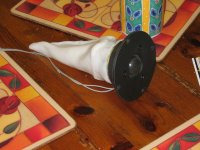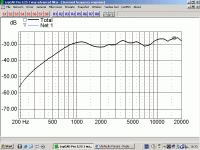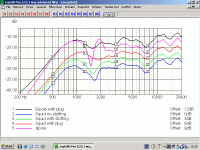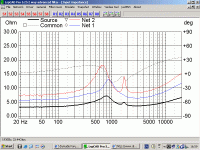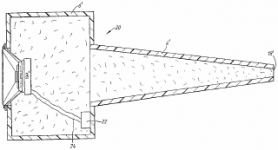I have always wondered if the cones on B&W tweeters and some midranges were really something to shout about or just a gimick designed to sell more speakers. Anyway a few months ago my dad discovered this stuff called polymorph when wandering around maplins and he purchased a tub. Today we were adding some moulded bits to his bike (all about aerodyanics etc) and I decided to modify a tweeter I had lying around.
THese were sold to me about 4 years ago as Morel MDT30s from wilmslow audio, they had the MDT30 stamp as a sticker on them and no other markings. They dont look like MDT30's but who knows its only the faceplate which looks different.
OK well I removed the plastic cup these come with, a really simple affair without any stuffing inside. Anyway I then moulded this plastic stuff completely free hand to the reverse of the tweeter and came up with this (see picture). I am yet to measure them but listening to them with a highpass at 300hz 1st order (single cap in series) the results are promising. I should have compared it to the other one but all in good time. I will post back when I have measured the two and compared them.
THese were sold to me about 4 years ago as Morel MDT30s from wilmslow audio, they had the MDT30 stamp as a sticker on them and no other markings. They dont look like MDT30's but who knows its only the faceplate which looks different.
OK well I removed the plastic cup these come with, a really simple affair without any stuffing inside. Anyway I then moulded this plastic stuff completely free hand to the reverse of the tweeter and came up with this (see picture). I am yet to measure them but listening to them with a highpass at 300hz 1st order (single cap in series) the results are promising. I should have compared it to the other one but all in good time. I will post back when I have measured the two and compared them.
Attachments
ITs a squid haha, Ill get back sometime, hopefully tomorrow with measurements of this thing in comparison to a non modified version.
I would have thought that if conical tubes on the chamber of a tweeter did give much better performance that all the best tweeters would come with them, I shall see.
Pinkmouse, if that nero thing is from danger mouse then I dont really get the joke I barely remember watching the show when I was younger. If however you are implying that my tweeter looks like that white catterpiller then I get it or maybe I dont It premiered in 1981 I wasnt even born yet😀
It premiered in 1981 I wasnt even born yet😀
I would have thought that if conical tubes on the chamber of a tweeter did give much better performance that all the best tweeters would come with them, I shall see.
Pinkmouse, if that nero thing is from danger mouse then I dont really get the joke I barely remember watching the show when I was younger. If however you are implying that my tweeter looks like that white catterpiller then I get it or maybe I dont
 It premiered in 1981 I wasnt even born yet😀
It premiered in 1981 I wasnt even born yet😀Penfold ruled.
I don't understand why you're putting the squid on the back? They don't need an enclosure, and it's not in the right place to have any dispersion/diffraction benefits. So i'm stumped.
Is DM your cousin PM?
I don't understand why you're putting the squid on the back? They don't need an enclosure, and it's not in the right place to have any dispersion/diffraction benefits. So i'm stumped.
Is DM your cousin PM?
Vikash said:Penfold ruled.
I don't understand why you're putting the squid on the back? They don't need an enclosure, and it's not in the right place to have any dispersion/diffraction benefits. So i'm stumped.
Is DM your cousin PM?
I simply had the materials available to try this, B&W think its worth doing, so I thought Id give it a go. I can certainly try listening and measuring dipole, that might work best anyway. Or with the tweeter in its own separate enclosure with very large internal volume relative to the tweeter as to be equivalent to free air.
Did you run it through SW yet? The B&Ws are also stuffed, you might want to try that. The other thing is to try modeling the with MJKs software, IIRC, there is a sheet for terminated lines.
Nah, He's a domesticated white mouse, I'm more of a wild and ferocious dormouse...🙂
Vikash said:Is DM your cousin PM?
Nah, He's a domesticated white mouse, I'm more of a wild and ferocious dormouse...🙂
Vikash said:Penfold ruled.
I don't understand why you're putting the squid on the back? They don't need an enclosure, and it's not in the right place to have any dispersion/diffraction benefits. So i'm stumped.
Is DM your cousin PM?
If I understand correctly, he's taken the rear chamber off the tweet so its no longer a sealed unit and replaced the realed chamber with a tapered pipe.
pinkmouse said:Nah, He's a domesticated white mouse, I'm more of a wild and ferocious dormouse...🙂
Meet your nemesis:
An externally hosted image should be here but it was not working when we last tested it.
Ferocious? By comparisson your avatar looks more like he's escaped from an institution. 😀
oh right. I didn't know the B&W's were open backed into those cones. I just assumed it was for looks on the tweeters. It'll be good to see what results you get 5th.Puggie said:If I understand correctly, he's taken the rear chamber off the tweet so its no longer a sealed unit and replaced the realed chamber with a tapered pipe.
Is it really dipole, since the dome surface area is completely backed by the top of the pole piece. Opening the chamber (or altering the encosed space behind a dome tweeter) would seem to have little benefit in terms of back wave reflection, unless the pole had a considerable size vent perhaps.5th element said:I can certainly try listening and measuring dipole, that might work best anyway.
from memory the pole vent in those tweets is about 3/8 to 1/2" diameter, with a small felt 'polo mint' on the exposed surface (which can cause funny impedance issues apparently if its not aligned properly).
Vikash said:
Is it really dipole, since the dome surface area is completely backed by the top of the pole piece. Opening the chamber (or altering the encosed space behind a dome tweeter) would seem to have little benefit in terms of back wave reflection, unless the pole had a considerable size vent perhaps.
You would be surprised I removed the cup/squid entirely and there is a lot of sound that escapes throught the pole vent.
PM I have stuffed the tube but cheers for the idea.
Puggie - you are correct there was is a small felt ring directly under the dome in the top of the front plate, I didnt move this. However I did remove the faceplate/dome before removing the original cup to make sure I didnt damage anything. Ive been up for an hour I will measure in an hour or two.
According to B&W's whitepapers (which I find fascinating), the enclosure is designed as a backwards horn. The benefits you get from horn loading a tweeter can be applied in reverse to absorb the rear-firing wave. If what they say is true, I would think that with a little bit of math, you could figure out what size/shape would be optimal (or at least get into the ballpark), then stuff it with padding that gets denser toward the tip of the backwards horn. In theory, this should work pretty well to absorb a significant amount of the tweeter's rear firing energy and prevent it from reflecting back to the dome surface.
Next up is the comparison of several different things I tried.
Going 2,3,4,5,1 (dont ask why),
2 is the squid without any stuffing material at all.
3 is the squid with stuffing, this is just standard BAF wadding.
Now quite a lot of tweeters (I know scans and some vifas do) have a plug on top of the vent under the dome, now the morel doesnt have this but it does have a felt plug on the otherside of the vent. Both 2 and 3 are without this in place, 4 is including the plug with squid stuffing.
5 is what happens if there is zero cup and plug.
6 is the same as 5 except the felt plug is in place. The felt plug seems to do more then the cup itself to the frequency response.
Going 2,3,4,5,1 (dont ask why),
2 is the squid without any stuffing material at all.
3 is the squid with stuffing, this is just standard BAF wadding.
Now quite a lot of tweeters (I know scans and some vifas do) have a plug on top of the vent under the dome, now the morel doesnt have this but it does have a felt plug on the otherside of the vent. Both 2 and 3 are without this in place, 4 is including the plug with squid stuffing.
5 is what happens if there is zero cup and plug.
6 is the same as 5 except the felt plug is in place. The felt plug seems to do more then the cup itself to the frequency response.
Attachments
For some reason I cannot make snapshots of impedance so your going to have to think a bit to compare the frequency responses to the impedance plots.
To overlay impedances on top of one another I made a 4way speaker and imported 4 different impedances for four different tweeter measurements then offset them slightly. So ignor the impedance at the source.
The yellow trace, which to my eyes is practically invisible, is the standard driver. The blue trace is the squid without any stuffing, the red trace is the squid with stuffing and the green is the squid with stuffing and the felt plug.
To overlay impedances on top of one another I made a 4way speaker and imported 4 different impedances for four different tweeter measurements then offset them slightly. So ignor the impedance at the source.
The yellow trace, which to my eyes is practically invisible, is the standard driver. The blue trace is the squid without any stuffing, the red trace is the squid with stuffing and the green is the squid with stuffing and the felt plug.
Attachments
Finally here is the factory model compared against the dipole version without the felt plug. I also measured the dipole with the plug but there wasnt any point in posting it, all it did was turn it into almost a replica of the factory model. Blue is factory model red is dipole.
Now having a brief listen to all of these versions I think I prefed the squid with stuffing and no felt plug, but this was full range and very hard to judge.
Now having a brief listen to all of these versions I think I prefed the squid with stuffing and no felt plug, but this was full range and very hard to judge.
Attachments
- Status
- Not open for further replies.
- Home
- Loudspeakers
- Multi-Way
- Tweeter modification
